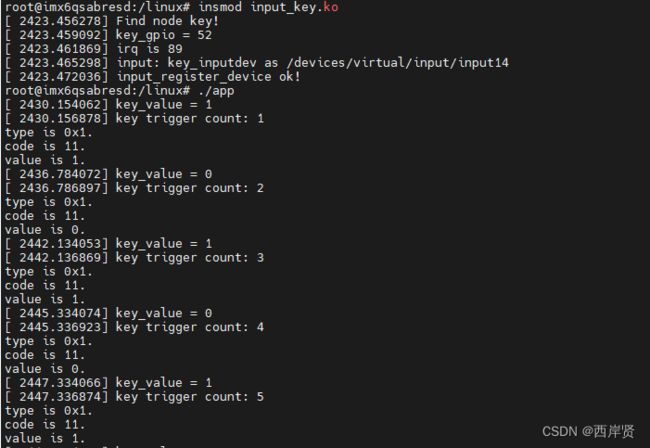Linux下input子系统
文章目录
- input子系统简单介绍
- 相关的函数
- input_dev注册过程
- 上报输入事件
- 按键的input子系统实验
input子系统简单介绍
input子系统是管理输入的子系统,和pinctrl和gpio子系统一样,都是Linux内核针对某一类设备而创建的框架。比如按键输入、键盘、鼠标、触摸屏等这些都属于输入设备,不同的输入设备所代表的含义不同,按键和键盘就是代表按键信息,鼠标和触摸屏代表坐标信息,因此在应用层的处理就不同,对于驱动编写者而言不需要去关心应用层的事情,我们只需要按照要求上报这些输入事件即可。input子系统分为input驱动层、input核心层、input事件处理层,最终给用户空间提供可访问的设备节点,input子系统框架如下图所示。

驱动层:输入设备的具体驱动程序,比如按键驱动程序,向内核层报告输入内容。
核心层:承上启下,为驱动层提供输入设备注册和操作接口。通知事件层对输入事件进行处理。
事件层:主要和用户空间进行交互。
input核心层会向Linux内核注册一个字符设备,具体的代码在/drivers/input/input.c文件中,input.c就是input输入子系统的核心层,其中注册了一个input类,系统启动后会在/sys/class目录下有一个input文件。

input子系统的所有设备主设备号都为13,我们在使用input子系统处理输入设备的时候不需要注册字符设备,只需要向系统注册一个input_dev即可。input_dev结构体定义在/include/linux/input.h文件中。
struct input_dev {
const char *name;
const char *phys;
const char *uniq;
struct input_id id;
unsigned long propbit[BITS_TO_LONGS(INPUT_PROP_CNT)];
unsigned long evbit[BITS_TO_LONGS(EV_CNT)];
unsigned long keybit[BITS_TO_LONGS(KEY_CNT)];
unsigned long relbit[BITS_TO_LONGS(REL_CNT)];
unsigned long absbit[BITS_TO_LONGS(ABS_CNT)];
unsigned long mscbit[BITS_TO_LONGS(MSC_CNT)];
unsigned long ledbit[BITS_TO_LONGS(LED_CNT)];
unsigned long sndbit[BITS_TO_LONGS(SND_CNT)];
unsigned long ffbit[BITS_TO_LONGS(FF_CNT)];
unsigned long swbit[BITS_TO_LONGS(SW_CNT)];
unsigned int hint_events_per_packet;
...
};
其中,keybit是按键事件使用的位图,evbit表示输入事件类型,可选的事件类型定义在/include/uapi/linux/input.h文件中,事件类型如下。
#define EV_SYN 0x00 //同步事件
#define EV_KEY 0x01 //按键事件
#define EV_REL 0x02 //相对坐标事件
#define EV_ABS 0x03 //绝对坐标事件
#define EV_MSC 0x04 //杂项(其他)事件
#define EV_SW 0x05 //开关事件
#define EV_LED 0x11 //LED
#define EV_SND 0x12 //sound
#define EV_REP 0x14 //重复事件
#define EV_FF 0x15 //压力事件
#define EV_PWR 0x16 //电源事件
#define EV_FF_STATUS 0x17 //压力状态事件
如果要用到按键,就要注册EV_KEY事件,如果要多次按下的话还需要注册EV_REP事件。
Linux内核定义了很多按键值,这些按键值定义在/include/uapi/linux/input.h文件中,如下。
#define KEY_RESERVED 0
#define KEY_ESC 1
#define KEY_1 2
#define KEY_2 3
#define KEY_3 4
#define KEY_4 5
#define KEY_5 6
#define KEY_6 7
#define KEY_7 8
#define KEY_8 9
#define KEY_9 10
#define KEY_0 11
...
可以将开发板上的按键值设置为其中的一个。
相关的函数
编写input设备驱动的时候需要先申请一个input_dev结构体变量, 使用input_allocate_device函数来申请一个input_dev,该函数原型如下。
struct input_dev *input_allocate_device(void)
返回值是申请到的input_dev。
申请好input_dev以后就需要初始化,需要初始化的内容主要为事件类型(evbit)和事件值(keybit)这两种。
初始化完成以后就需要向Linux内核注册input_dev了,需要用到input_register_device函数,此函数原型如下。
int input_register_device(struct input_dev *dev)
dev表示要注册的input_dev,返回值为0表示注册成功,返回负值表示注册失败。
注销的时候需要使用input_unregister_device函数,函数原型如下。
void input_unregister_device(struct input_dev *dev)
注销的input设备需要使用input_free_device函数来释放input_dev,input_free_device函数原型如下。
void input_free_device(struct input_dev *dev)
input_dev注册过程
使用input_allocate_device函数申请一个input_dev;初始化input_dev的事件类型以及事件值;使用input_register_device函数向Linux系统注册前面初始化好的input_dev;卸载input 驱动的时候需要先使用input_unregister_device函数注销掉注册的input_dev,然后使用input_free_device函数释放掉前面申请的input_dev。
input_dev注册过程的大体框架如下。
struct input_dev *inputdev; //定义input子系统结构体变量
static int __init xxx_init(void) //驱动入口函数
{
...
inputdev = input_allocate_device(); /* 申请input_dev */
inputdev->name = "test_inputdev"; /* 设置input_dev 名字 */
/*第一种设置事件和事件值的方法*/
__set_bit(EV_KEY, inputdev->evbit); /* 设置产生按键事件 */
__set_bit(EV_REP, inputdev->evbit); /* 重复事件 */
__set_bit(KEY_0, inputdev->keybit); /*设置产生哪些按键值 */
/*第二种设置事件和事件值的方法*/
keyinputdev.inputdev->evbit[0] = BIT_MASK(EV_KEY) | BIT_MASK(EV_REP);
keyinputdev.inputdev->keybit[BIT_WORD(KEY_0)] |= BIT_MASK(KEY_0);
/*第三种设置事件和事件值的方法*/
keyinputdev.inputdev->evbit[0] = BIT_MASK(EV_KEY) | BIT_MASK(EV_REP);
input_set_capability(keyinputdev.inputdev, EV_KEY, KEY_0);
/* 注册input_dev */
input_register_device(inputdev);
return 0;
}
static void __exit xxx_exit(void) //驱动出口函数
{
input_unregister_device(inputdev); /* 注销input_dev */
input_free_device(inputdev); /* 释放input_dev */
}
上报输入事件
以上工作完成后还不能使用input设备,input设备都是具有输入功能的,但是具体是什么样的输入值Linux内核是不知道的,因此需要获取到具体的输入值或输入事件,然后将其上报给Linux内核。比如按键,我们需要在按键中断处理函数,或者消抖定时器中断函数中将按键值上报给Linux内核,这样Linux内核才能获取到正确的输入值。
input_event函数用于上报指定的事件以及对应的值,函数原型如下。
void input_event(struct input_dev *dev,unsigned int type,unsigned int code,int value)
dev是需要上报的input_dev;type是上报的事件类型,比如EV_KEY;code是事件码,即注册的按键值,比如KEY_0、KEY_1等;value表示事件值,比如1表示按键按下,0表示按键松开。
input_event函数可以上报所有的事件类型和事件值,Linux内核也提供了其他的针对具体事件的上报函数, 这些函数其实都用到了input_event函数。比如上报按键所使用的input_report_key函数,此函数内容如下。
static inline void input_report_key(struct input_dev *dev,unsigned int code,int value)
{
input_event(dev, EV_KEY, code, !!value);
}
上报事件以后还需要使用input_sync函数来告诉Linux内核input子系统上报结束,input_sync函数本质是上报一个同步事件,此函数原型如下。
void input_sync(struct input_dev *dev)
input_event结构体定义在/include/uapi/linux/input.h文件中,其内容如下。
struct input_event {
struct timeval time;
__u16 type;
__u16 code;
__s32 value;
};
time是此事件发生的时间,type是事件类型,code是事件码,value是值。
按键的input子系统实验
输入子系统实验的源代码如下。
#include 经过自己验证,不要在代码中设置EV_REP,因为这样收到的值不太正确,具体的原因自己也没找到。
测试代码的内容如下。
#include 上面代码中打开的文件可以通过下图所示的方式得知。

首先在没有加载驱动的时候看看/dev/input下的文件,然后加载驱动后多出来的那一个就是要打开的。
可以通过命令 cat /proc/bus/input/devices查看驱动加载成功后的输入设备信息,如下图所示

名字和代码中设置的一致,事件也对应的是驱动加载成功以后多出来的文件。
超级终端打印的信息如下图所示。

type的类型值为0x1,表示这是一个按键事件。
#define EV_KEY 0x01 //按键事件
code的值是11,这是因为我在代码中使用了KEY_0。
#define KEY_0 11
value的值就是通过输入子系统传来的,定义输入事件结构体读取到传来的值,可以看到,其和key_value的值相等,这就说明传过来的值是正确的。
进一步拓展,input子系统也可以配合LED的驱动来使用,分别加载按键和LED的驱动,然后在测试程序中将读取到的值写入LED中,这样,LED的亮灭就是通过按键控制的。
#include 运行过程中的打印信息如下图所示。

可以看到,LED的亮灭状态随着键值的变化而变化,说明确实是按键控制着LED的状态。
总的来说,input子系统的引入不再需要我们再定义字符设备,input核心层会向Linux内核注册一个字符设备。
本文参考文档:
I.MX6U嵌入式Linux驱动开发指南V1.5——正点原子